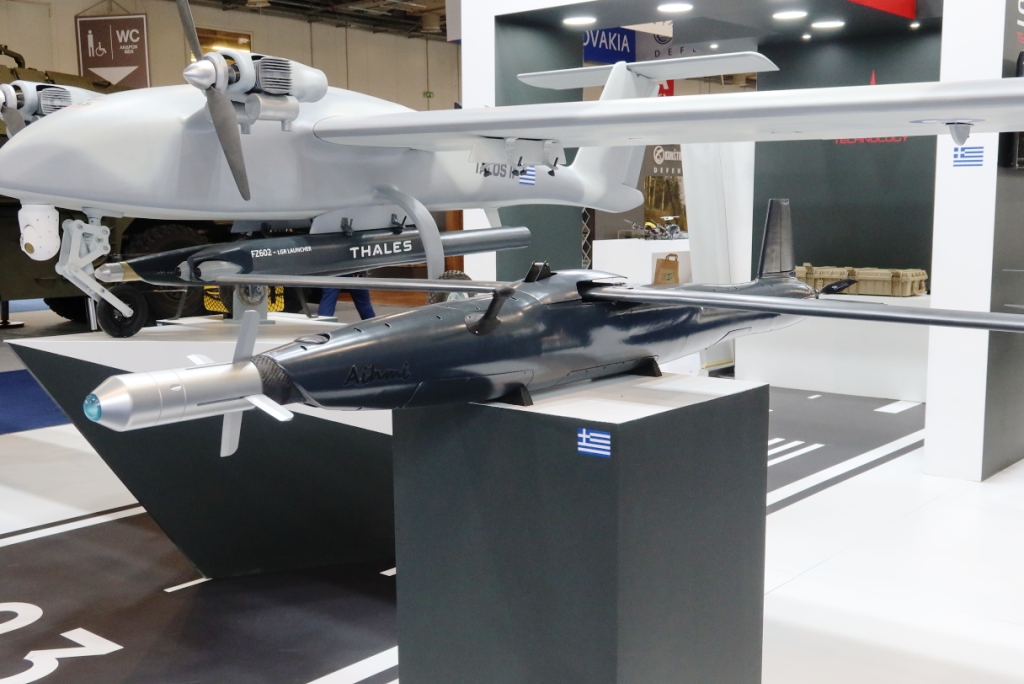
DEFEA 2023 – Beating the tactical bubble with S.A.S. Technology Aihmi AHM-1X SOLM
Improving the safety of manned or unmanned platforms armed with rockets, this was the aim of the S.A.S. Technology management when it decided to invest in the Aihmi AHM-1X project
Very short-range air defence systems improving performances and the deployment of vehicles with cannons of increasing calibre, coupled to counter UAS systems, make the areas over the battlefield dangerous for helicopters and UAVs, which guided or unguided rockets are more and more outranged by ground-based air defences even at the tactical level. The Greek company, specialised in unmanned systems, started therefore developing an airframe to increase the range of 2.75 inch rockets, closely cooperating with Thales, the latter proposing this type of weapon either unguided or with its guidance kit.
The resulting system was named Aihmi, spearhead in Greek, and comes in the form of a UAS with high wing fitted with an electric motor at the back which activates a two-blade pushing propeller (as option it can also be used as a glider without any propulsion system). The difference from other UAS is that at the front a 2.75 inch (70 mm) rocket is inserted in the UAS body, the whole system being 1.82 metres long, its wingspan being 1.98 metres. Before launch wings are folded back along the fuselage, and extend just after launch. The overall weight is 16 kg, 12 of which are represented by the rocket itself, the airframe being made nearly entirely of carbonfibre.

The engine battery allows for a 15 minutes powered flight at a speed up to 140 km/h, then the systems start its gliding approach, the glide ratio being between 13 and 15, which means that if launched at 2,000 meters it will travel for 26-30 km. Range is therefore very much depending on the releasing altitude over ground. Guidance is provided by a GPS/inertial system.
If fitted with a guided munition, in the final phase guidance will be provided by the reflected laser beam of a third party illuminator. At this point the warhead will be armed and once inbound, that is usually when closer than 7 km from the target, the rocket will be fired leaving behind it the carbonfibre airframe and expulsing the rear electric motor, and will start its travel towards the hit point. Standard CEP is less than 1 metre.
Should the Aihmi be fitted with an unguided rocket, it will follow the same path but then it will be the operator who will select the target, a two-way datalink allowing him to follow the entire operation (by the way this ensures the man-in-the-loop also when using guided rocket). The silent approach, at that time the electric motor will have finished its function, allows closing on the target as much as possible, thus reducing the typical error or unguided rockets as much as possible.
The Aihmi AHM-1X is currently undergoing flight tests, and once those will be completed S.A.S. Technology will start firing tests, in cooperation with Thales. According to the company, when launched from an altitude of 1,000 metres over ground, the Aihmi in the powered version will fly for 45 kg with the engine running and will then start a 15 km gliding approach, which makes a total distance of 60 km, putting the system in the Stand-Off Loitering Munition, or SOLM, category. Used as a simple glider the range from the same altitude will be reduced to 15 km.

S.A.S. Technology proposes the Aihmi AHM-1X as a weapon for its SRS-1A Sarisa (Spear in Greek) VTOL UAS, which has a 25 kg payload capacity and can thus carry one SOLM, as well as for its Thalos II fixed wing UAS, which can carry up to four AHM-1X.
Photos by P. Valpolini



